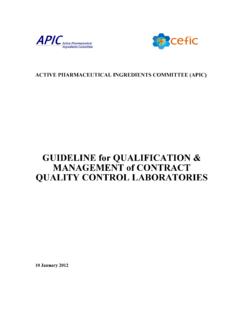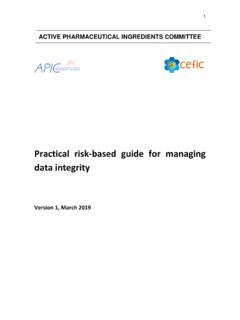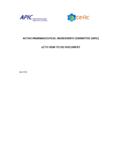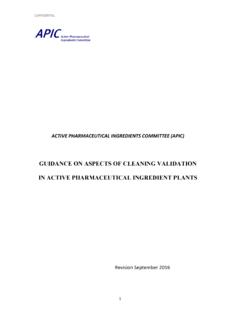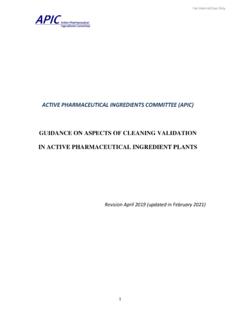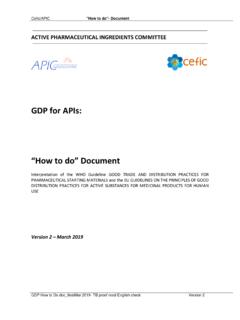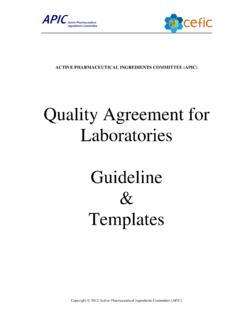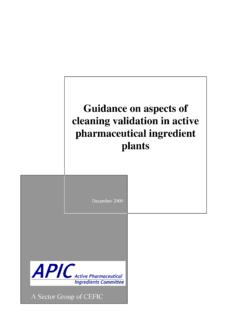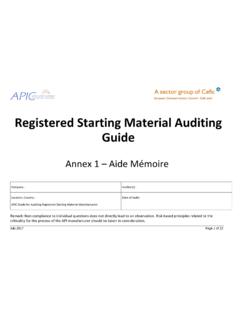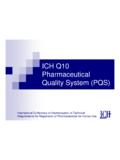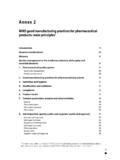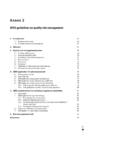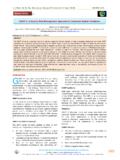Transcription of Quality Management System - apic.cefic.org
1 Quality Management System (QMS) for Active pharmaceutical Ingredients (API) Manufacturers integrating GMP (ICH Q7a) into ISO (9001: 2000) September 2005 APIC / CEFIC Quality Management System - integrating GMP (ICH Q7a) into ISO (9001: 2000) Page 2 of 73 Table of Contents I. Introduction II. Objective and Scope III. Quality Management Systems for API manufacturers 1. Quality Management System 2. Management responsibility 3. Resource Management 4. Product realization (Manufacturing Operations) 5. Measurement, analysis and improvement (Evaluation Activities) IV. Supplementary Information 1. Identification of System approaches in Q7a 2. Description of processes 3. Structure of a Quality Manual 4.
2 Cross-reference of APIC QMS documents (from old to new ) 5. Assistance for implementation of a QMS 6. Matrix GMP(Q7a) / ISO (9001:2000) V. Glossary VI. Abbreviations VII. References VIII. Acknowledgements APIC / CEFIC Quality Management System - integrating GMP (ICH Q7a) into ISO (9001: 2000) Page 3 of 73 I. Introduction The changing regulatory environment In a Science Board Meeting held in November 2001, FDA raised some concerns regarding the efficiency of the pharmaceutical industry. The factors contributing to this situation were identified as follows: Pharmaceuticals are complex, multivariate physicochemical systems that are - Often treated (during development) as univariate systems (one-factor-at-a-time, trial-and-error experimentation) - Physical properties of materials normally not well characterized - Equipment selection based on tradition - Process factors are not well understood Development is done under time crunch Post approval changes require regulatory oversight It was said that a higher efficiency is required in order to provide high Quality drugs to the market in a timely manner, to successfully take advantage of the new drug development opportunities offered by advances in chemistry and biology.
3 In addition, one should also ensure the optimal utilization of public and private resources to meet the growing health care needs and, last but not least, to obtain global competitiveness for the pharmaceutical industry. The consequences are that the status quo is no longer tenable and that the pharmaceutical manufacturing could be much better. Furthermore, it is claimed that traditional metrics hide poor performance, and that compliance infrastructures are not economic. Currently, utilization levels are judged to be down to 15 percent or less, and costs in terms of Quality are in excess of 20 percent. The agency s conclusions were that often processes are transferred that are neither fully understood nor capable of being so at commercial scales.
4 Also, there is a lack of scientific basis for deeper process understanding. Further, the pharmaceutical manufacturers fall short in the ability of a process to be right the first time ( pro-active Quality Management , six sigma approach) Under the umbrella of the GMP for the 21st century initiative, the FDA started an international co-operation to find answers to the current situation covering the following topics: A science based approach Risk Management QSIT ( Quality System Inspection Technique) PAT (Process Analytical Technology) QSIT and PAT The Quality System Inspection Technique moves the FDA from reviewing all documentation to a System -based inspection covering the following six subsystems: Quality System Facilities and equipment System Production System Packaging and labeling System Laboratory controls System Materials System APIC / CEFIC Quality Management System - integrating GMP (ICH Q7a) into ISO (9001: 2000) Page 4 of 73 Scientific and technological advances in the area of process analytical chemistry, engineering, and multivariate data analysis offer new opportunities for improving the overall efficiencies of drug development, manufacturing and regulatory processes.
5 Although for many years the pharmaceutical community has recognized the need for improvements in these areas, little progress has been made. Therefore FDA forced the development of PAT (Process Analytical Technology). PAT is a model to facilitate the discussion on of emerging regulatory science issues in pharmaceutical manufacturing. PAT provides an opportunity to move from the current testing to document Quality paradigm to a Continuous Quality Assurance paradigm that can improve the ability to ensure Quality that was built-in or was by-design the ultimate realization of the true spirit of GMP. It is the expectation of the industry that these initiatives will result in improved product Quality , reduced manufacturing cycle times, reduced laboratory testing burdens and costs.
6 QMS combining ISO and GMP Overall, there is a clear tendency of authorities towards Quality Management Systems (QMS), as already outlined in some new guidelines, in ICH Q7a, Section Each manufacturer should establish, document, and implement an effective System for managing Quality that involves the active participation of Management and appropriate manufacturing personnel . Finally, ISO 9002 already stated in the introduction: It is emphasized that the Quality System requirements specified in this International Standard are complementary not alternative - to the technical (product) specified requirements . As early as 1997 a guideline on the integration of the GMP requirements with the QMS requirements, issued by CEFIC/APIC, was available for the API manufacturers.
7 Introduction to the old APIC version (excerpt) Because the pharmaceutical industry has traditionally focused upon the application of Good Manufacturing Practice (GMP), it has been slow to consider the potential benefits to be gained by implementing an EN ISO 9001 Quality Management System (QMS). Over the last few years the global pharmaceutical market has undergone significant change, forcing pharmaceutical companies, more than ever before, to focus on customer needs and upon their own internal efficiency in order to continue to compete effectively. With this in mind CEFIC commissioned a working group of experts drawn from several major Active pharmaceutical Ingredients (API) producers to prepare a practical, user-friendly guidance document integrating current GMP requirements into the EN-ISO 9001 QMS framework.
8 To achieve this the working group have taken relevant features from the August 1996 CEFIC/EFPIA publication Good Manufacturing Practice for Active Ingredients Manufacturers and combined these with the relevant complementary requirements of EN-ISO 9001 Quality Systems: Model for Quality assurance in design, development, production, installation and servicing . It was intended that these Guidelines would be applicable to all APIs. To facilitate understanding of this composite guidance document it is important for the reader to be aware of the following points: EN-ISO 9001 is a generic, business-focused standard that supports the effective Management of Quality to an internationally recognized level of best practice.
9 It is flexible in that it specifies what is to be achieved, but allows each company freedom to determine, and justify, how these requirements are achieved. In contrast, GMP is an industry-specific standard prescribing what should be done to ensure product safety and efficacy. Thus, EN-ISO 9001 benefits the business by ensuring the Quality of the Management System , while GMP ensures that Quality is built during the whole manufacturing and control process and that regulatory requirements are met. APIC / CEFIC Quality Management System - integrating GMP (ICH Q7a) into ISO (9001: 2000) Page 5 of 73 Although there is inevitably some overlap between the requirements of a QMS and GMP they are, in fact, highly complementary. This view is supported by a statement in the introduction to the PIC ( pharmaceutical Inspection Convention, now called PIC/S) GMP Guideline which refers to.
10 A correctly implemented System of Quality Assurance incorporating GMP .. , and by the wording of the introduction in ISO itself which points out that .. this international standard is complementary - not alternative - to the technical (product) specified requirements . The interrelationship between EN-ISO 9001 and API GMP is illustrated in this guidance document by a matrix cross-referencing the main QMS elements and GMP requirements. To be effective the QMS should have the visible and ongoing support of top Management . To fully benefit the company the QMS should involve all staff whose activities influence Quality , have a clear and unambiguous continuous improvement focus, and incorporate relevant, realistic performance measures with emphasis on reducing failure costs, and satisfying (internal and external) customer needs.
